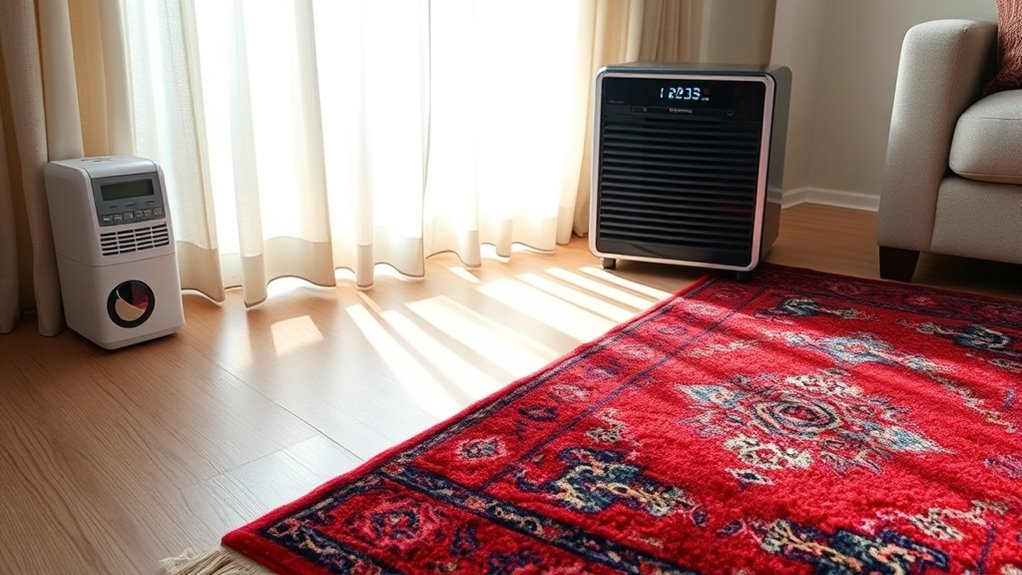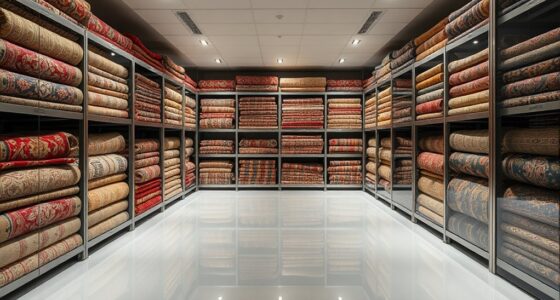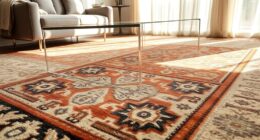To prevent rug dry-rot, keep indoor humidity levels between 40% and 60%. Use reliable hygrometers to monitor moisture, and adjust with dehumidifiers or humidifiers as needed. Guarantee proper ventilation and use high-quality vapor barriers under floors. Maintain your HVAC system and fix leaks promptly. Regular inspections help catch problems early. If you want to know more about effective moisture management strategies, keep exploring these helpful tips.
Key Takeaways
- Maintain indoor humidity levels between 40% and 60% to prevent excess moisture that causes dry rot.
- Use dehumidifiers in damp areas like basements and near rugs to control moisture buildup.
- Ensure proper ventilation with exhaust fans and air exchange systems to reduce indoor humidity.
- Install vapor barriers beneath concrete slabs and in crawl spaces to limit moisture infiltration.
- Regularly inspect and promptly repair leaks or water intrusion to prevent persistent dampness that leads to dry rot.
Understanding the Impact of Humidity on Rug Health
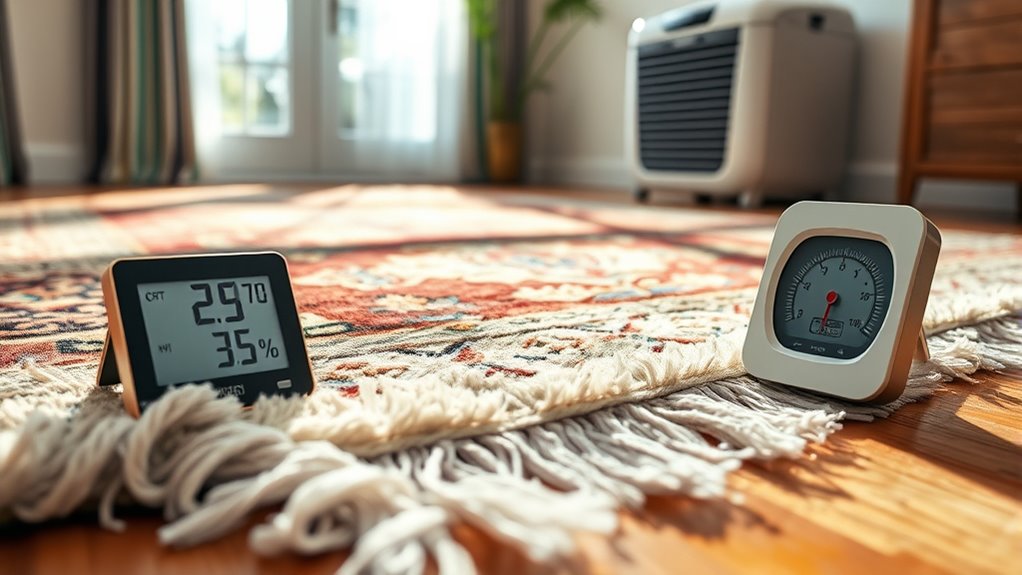
Humidity levels directly affect the durability and appearance of your rugs. When humidity is too high, excess moisture can lead to mold growth, attracting pests and causing fibers to weaken over time. Conversely, low humidity causes fibers to dry out and become brittle, increasing the risk of cracking and fraying. Maintaining *ideal* humidity helps preserve the rug’s color, texture, and structural integrity. Fluctuations can cause fibers to expand and contract, leading to warping or unraveling. Proper humidity control prevents these issues, ensuring your rugs stay vibrant and intact longer. Additionally, understanding how climate control impacts interior environments can help you create a more stable setting for your rugs. Understanding how moisture impacts your rug’s health allows you to take proactive steps, like adjusting indoor humidity levels, to keep your rugs looking their best and avoid costly repairs or replacements.
Monitoring Indoor Humidity Levels Effectively
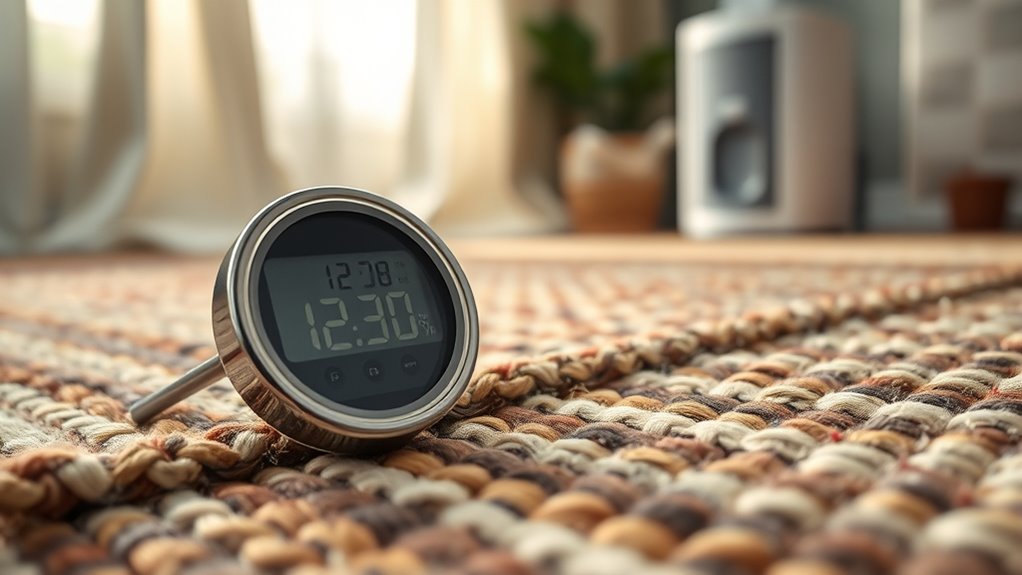
To keep your indoor environment comfortable, you need reliable humidity measurement devices. These tools help you track levels and guarantee they stay within the ideal range. By monitoring accurately, you can make informed adjustments to maintain ideal indoor humidity. Using devices with auto functions can further optimize air quality by adjusting settings dynamically based on real-time readings.
Humidity Measurement Devices
Ever wondered how you can accurately monitor indoor humidity levels? The key is using the right humidity measurement devices. Digital hygrometers are popular because they provide quick, precise readings and are easy to read. Analog hygrometers, often using a dial, are simple and budget-friendly but may require calibration for accuracy. Combination devices also measure temperature alongside humidity, giving you a thorough view of your environment. When choosing a device, consider factors like placement, ease of use, and calibration capabilities. Properly functioning hygrometers help you keep humidity levels in check, preventing conditions that promote rug dry-rot. Regularly checking your device ensures consistent readings, so you can make informed adjustments to protect your rugs and maintain a healthy indoor environment. Calibration techniques are vital to ensure your hygrometer provides accurate data over time.
Optimal Indoor Levels
Maintaining the right indoor humidity levels is essential for a healthy and comfortable environment. Aim for a humidity range between 40% and 60%. This level prevents mold growth, reduces dust mites, and keeps your rugs in good condition. Use a reliable hygrometer to monitor indoor moisture regularly. During dry seasons, consider using a humidifier to add moisture, especially in rooms with rugs or furniture sensitive to dryness. Conversely, during humid periods, run a dehumidifier or improve ventilation to lower excess moisture. Keep windows open when weather permits to help balance indoor humidity naturally. Additionally, choosing air purifiers with advanced filtration technology can help reduce airborne allergens and odors, contributing to a healthier indoor environment. Keep your rugs dry and mold-free by consistently maintaining optimal humidity levels, protecting your home from dry‑rot and other humidity-related issues.
Using Dehumidifiers to Maintain Optimal Moisture Balance
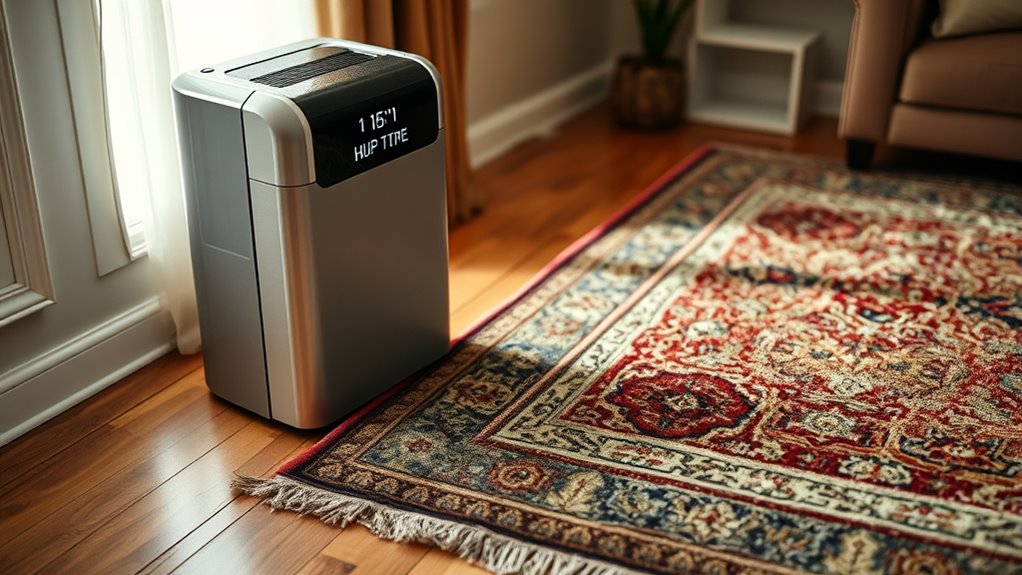
Using dehumidifiers is an effective way to keep indoor humidity levels in check, especially in areas prone to excess moisture. They actively remove excess moisture from the air, preventing conditions that foster mold and dry-rot. To get the best results, select a dehumidifier suited to your space’s size and set it to maintain humidity between 40-50%. Regularly empty the water reservoir or ensure your unit’s drainage system is functioning properly. Keep doors and windows closed when the dehumidifier is running to maximize efficiency. Place the unit in areas most vulnerable to moisture, like basements or near rugs. Additionally, understanding the contrast ratio of your environment can help you optimize the placement of dehumidifiers for better performance. By maintaining consistent humidity levels with a dehumidifier, you protect your rugs from dry-rot and create a healthier indoor environment.
Ensuring Proper Ventilation in High-Humidity Areas

Effective ventilation system design is essential to prevent excess moisture in high-humidity areas. By managing airflow properly, you can prevent mold growth and maintain a comfortable environment. Paying attention to moisture levels helps ensure your ventilation efforts work efficiently. Utilizing appropriate spray tips can also improve the application of sealants or coatings that help control humidity levels.
Ventilation System Design
Have you ever wondered how proper ventilation can prevent high humidity from causing problems? A well-designed ventilation system controls moisture levels by continuously exchanging stale, humid air with drier outside air. Start by choosing the right type of system—exhaust fans, air exchange units, or balanced ventilation systems—that suit your space’s size and humidity needs. Make sure vents are strategically placed near high-moisture sources like bathrooms or kitchens, and ensure airflow is unobstructed. Proper duct sizing and airflow rates are essential to avoid stagnant air pockets. Regular maintenance, such as cleaning filters and inspecting vents, keeps the system effective. Understanding spiritual connections and love can also remind us of the importance of harmony and balance, which parallels the need for equilibrium in ventilation for optimal humidity control. With good design, your ventilation system becomes a reliable barrier against excess humidity, protecting your rug and preventing dry-rot.
Managing Moisture Levels
Managing moisture levels in high-humidity areas requires careful attention to ventilation to prevent mold, musty odors, and damage. You should guarantee proper airflow by opening windows, using exhaust fans, or installing vents that promote air exchange. Keep humidity levels below 60%, ideally around 50%, with dehumidifiers if needed. Regularly inspect for signs of excess moisture, such as condensation on windows or walls. Avoid clutter that can trap humidity and obstruct airflow. When ventilating, focus on areas prone to moisture, like bathrooms, kitchens, and basements. Proper ventilation not only reduces humidity but also helps dry out any damp materials quickly, preventing the development of dry-rot and other issues. Consistent moisture management keeps your space healthier and preserves your rugs and belongings. Utilizing a keto diet app can help track and manage your environmental conditions effectively, ensuring optimal airflow and humidity levels for your space.
Managing Humidity With Air Conditioning Systems
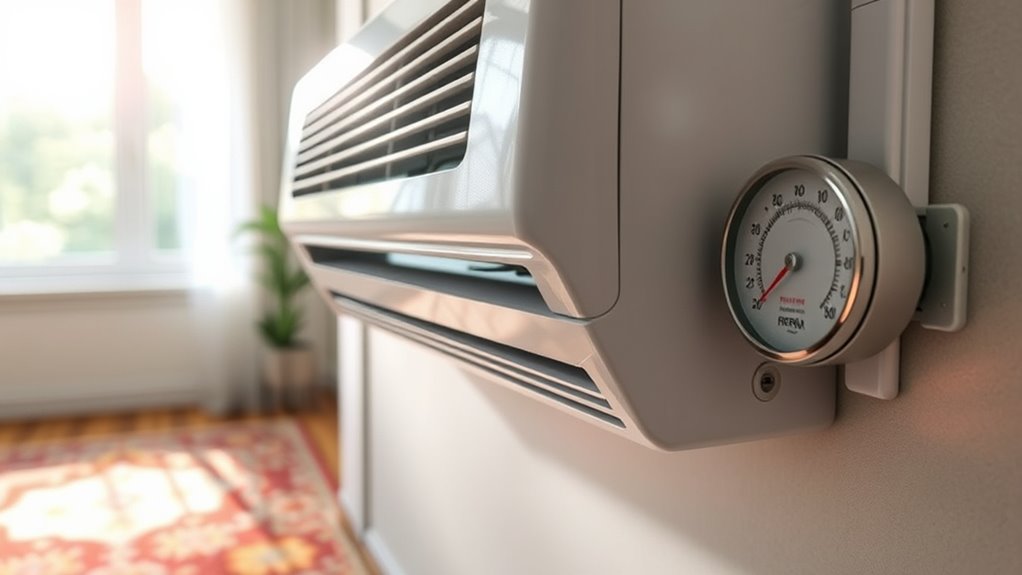
Air conditioning systems play a crucial role in controlling indoor humidity levels, especially during hot or damp weather. When you run your AC, it not only cools the air but also dehumidifies it by removing excess moisture. This helps maintain a balanced humidity level, reducing the risk of rug dry-rot caused by prolonged dampness. To optimize this, set your thermostat to a comfortable temperature, typically between 72-78°F, which encourages the AC to run efficiently and dehumidify effectively. Make sure your system is properly maintained, with clean filters and regular servicing. Using a dehumidifier alongside your AC can further reduce humidity if needed. Properly managing humidity with your air conditioning system creates a healthier, more stable environment that protects your rugs from moisture damage. Additionally, best airless paint sprayers showcase how efficient moisture control can be achieved with the right equipment, emphasizing the importance of proper maintenance and operation for lasting results.
Implementing Moisture Barriers and Vapor Retarders

Did you know that installing moisture barriers and vapor retarders can considerably reduce indoor humidity and protect your rugs from mold and rot? These barriers act as a shield, preventing moisture from seeping into flooring and subflooring materials. You should place vapor retarders beneath concrete slabs, in crawl spaces, or between wall assemblies to block moisture transmission. Make sure they’re properly sealed at all edges to maximize effectiveness. Using high-quality materials, like polyethylene sheeting or specialized vapor barriers, helps maintain a dry environment. Proper installation is key—overlapping seams and sealing gaps prevent moisture from bypassing the barrier. Creativity can be cultivated by anyone, and implementing these barriers creates a controlled environment that reduces humidity levels, keeping your rugs dry and preventing the growth of mold and dry‑rot.
Addressing Leaks and Water Intrusion Promptly
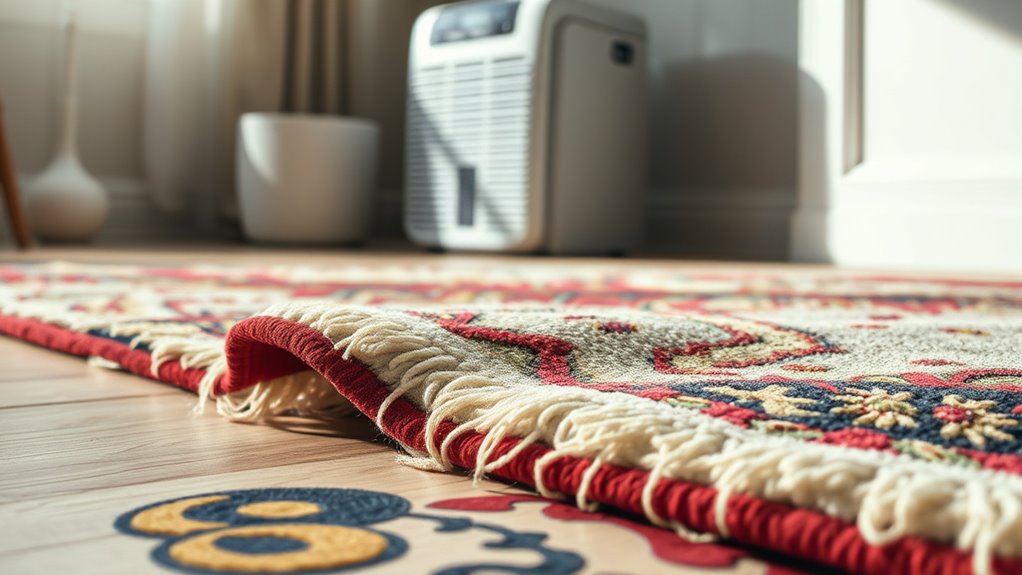
When you notice signs of leaks or water intrusion, it’s vital to act quickly to prevent extensive damage. Start by locating the source of the leak and stopping it immediately. Whether it’s a burst pipe, faulty roofing, or plumbing issues, addressing the root cause prevents ongoing moisture problems. Dry the affected area thoroughly using fans, dehumidifiers, or absorbent materials. Check for hidden water behind walls or under flooring, and repair any structural damage as needed. Keep an eye out for mold, mildew, or musty odors, which indicate persistent moisture. Prompt action minimizes the risk of dry rot and mold growth that can weaken your rugs and underlying structures. Remember, swift response is your best defense against water-related damage and long-term humidity issues.
Choosing the Right Flooring and Underlayments for Moisture Control
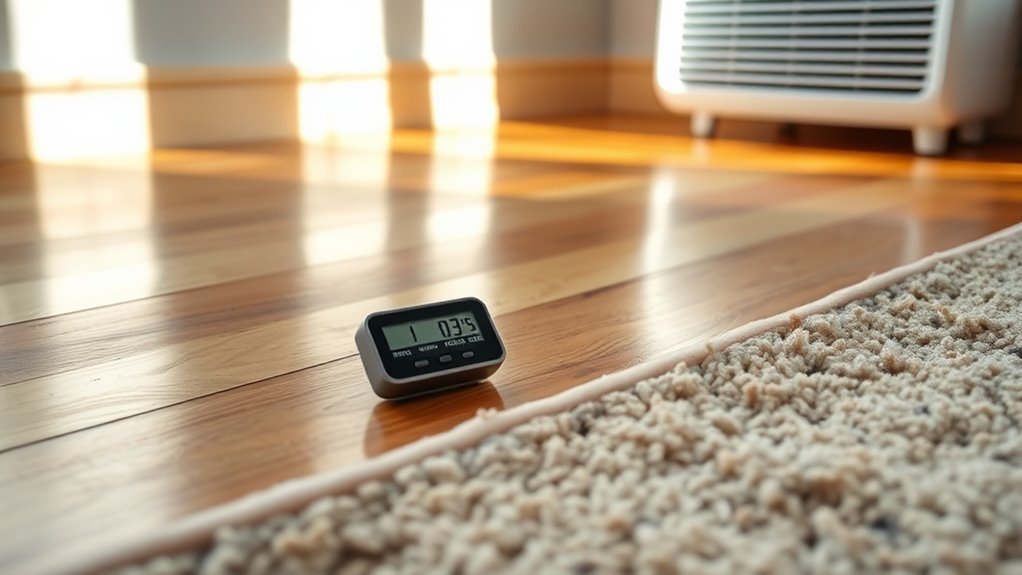
Choosing the right flooring and underlayments plays a vital role in managing moisture and preventing long-term damage. The materials you select can either trap humidity or allow moisture to escape, impacting rug longevity. To optimize moisture control, consider these key factors:
- Use moisture-resistant underlayments like foam or rubber that block dampness from the subfloor.
- Opt for flooring materials such as ceramic tile or sealed concrete that resist water penetration.
- Avoid porous options like hardwood or carpet without proper vapor barriers, which can trap moisture and promote rot.
Regular Maintenance and Inspection for Long-Term Protection
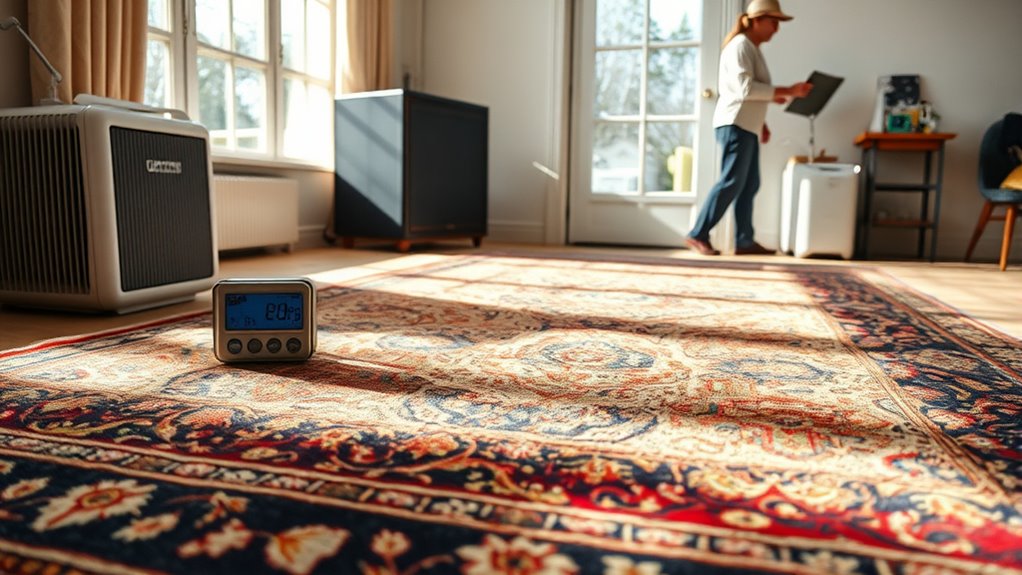
Regular maintenance and regular inspections are essential to guarantee your moisture control measures remain effective over time. You should routinely check for signs of excess humidity, mold, or dampness around your rug and flooring. Ensure vents and dehumidifiers operate properly, and clean filters regularly. Inspect seams and edges for wear or gaps that might let in moisture. Use the table below to identify common issues and solutions:
| Issue | Solution |
|---|---|
| Rising humidity levels | Use dehumidifiers and improve ventilation |
| Visible mold | Clean with appropriate fungicides |
| Warped or buckled rug | Adjust humidity and inspect for leaks |
| Gaps in flooring | Seal with appropriate materials |
| Foul odors | Address moisture sources immediately |
Consistent checks help prevent dry-rot, saving you time and expense down the line.
Frequently Asked Questions
What Are the Signs of Rug Dry‑Rot Caused by Humidity?
You might notice your rug developing a musty smell or visible mold spots, which are signs of dry-rot caused by high humidity. You could see fibers becoming brittle, discolored, or breaking apart more easily. If you observe a damp or damp-looking area on your rug, it’s a clear warning. These signs indicate excessive moisture, so it’s essential to address humidity levels quickly to prevent further damage.
How Does Outdoor Climate Affect Indoor Humidity Levels?
A stitch in time saves nine, and understanding outdoor climate helps you keep indoor humidity in check. When it’s humid outside, moisture seeps in through windows and walls, raising indoor humidity levels. Conversely, dry weather can lower indoor moisture, causing rugs to dry out and crack. You’ll want to monitor weather patterns and use dehumidifiers or humidifiers as needed to maintain balanced indoor conditions and protect your rugs.
Can Humidity Control Prevent Mold Growth on Rugs?
Yes, controlling humidity can prevent mold growth on your rugs. When indoor humidity stays between 30-50%, it limits mold spores from thriving. You can use dehumidifiers, air conditioners, and proper ventilation to maintain these levels. Regularly cleaning and drying your rugs also helps. By actively managing humidity, you create an environment less hospitable to mold, protecting your rugs and maintaining healthier indoor air quality.
Are There Specific Humidity Levels Recommended for Different Rug Materials?
Did you know that maintaining indoor humidity between 30-50% reduces mold risk on rugs? You should aim for specific levels based on your rug material. For natural fibers like wool, keep humidity around 40-50%, while synthetic rugs tolerate slightly lower levels. Using a hygrometer helps you monitor these levels easily, ensuring your rugs stay dry and mold-free. Adjust humidity accordingly to protect your investment and extend your rug’s lifespan.
How Often Should Indoor Humidity Be Checked for Optimal Rug Preservation?
You should check your indoor humidity levels at least once a week to guarantee ideal rug preservation. Use a reliable hygrometer to monitor the moisture in your space, aiming for a humidity level between 40 and 50 percent. Regular checks help you catch fluctuations early, allowing you to adjust humidifiers or dehumidifiers as needed. Staying consistent prevents dryness or excess moisture that could damage your rugs over time.
Conclusion
By keeping humidity in check, you protect your rugs from dry-rot and damage. Regularly monitor levels, use dehumidifiers, and guarantee proper ventilation. Address leaks promptly and choose moisture-resistant flooring. Remember, an ounce of prevention is worth a pound of cure—staying proactive keeps your rugs looking their best for years to come. With consistent care, you’ll preserve your home’s comfort and beauty, making sure your rugs stand the test of time.
